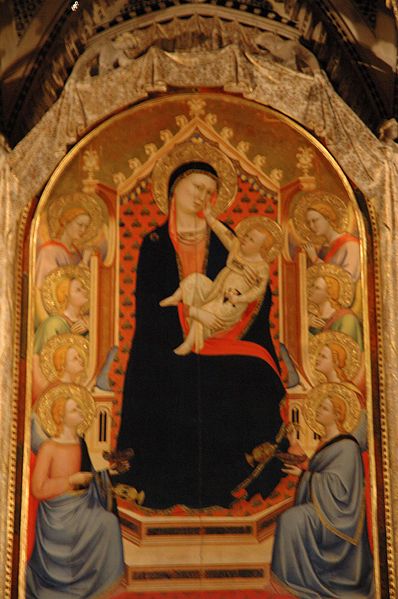Hey guys! Let’s explore more ‘hidden’ places and masterpieces in town.
Right in the heart of Florence is Orsanmichele with its famous (copies of) sculptures of the patron saints of Florentine guilds. While many people often stop to take pictures of these sculptures displayed on the church’s exterior, not many visitors take the time to actually go inside the church where more wonders await. The dim, quiet interior of the church is lined with beautiful stained glass windows showing scenes and miracles from the life of the Virgin Mary, providing a contemplative atmosphere for viewing the other artworks in the church. The 1346 Madonna and Child by Bernardo Daddi (a student of Giotto) and its magnificent tabernacle made of marble, glass and inlaid stone by Andrea Orcagna is the dominant structure inside. Daddi’s painting seen today replaced an earlier miracle-working image of the Madonna. All this and more await anyone who simply takes the time to look, a good lesson for all churches in Florence: always take a moment to peek inside because there are always new things to discover!
Two more churches on the other side of the Arno River lie off the beaten tourist track but are still easily reachable on foot and won’t cost you a single euro to experience some of the city’s greatest artistic masterpieces. Right on the other side of the Ponte Vecchio is the small Piazza Santa Felicita with its church of the same name (the oldest church in the Oltrarno area of Florence!) tucked into the corner of the piazza. While every visitor to Florence makes sure to walk across the famous Old Bridge, most usually walk right by Santa Felicita on their way to the much larger and grander Pitti Palace right down the street. The Old Bridge, church has a very distinctive exterior: part of the Vasari Corridor, a passageway built in 1565 for the Medici family that connects the Palazzo Vecchio and the Pitti Palace, runs across its façade. Immediately upon entering the church, look to your right at the first chapel lining the side wall: Filippo Brunelleschi, the famous architect of the cathedral cupola, originally built this chapel in the early 15th century for the Barbadori family.
Today, however, it is known as the Capponi chapel, bearing the name of the family who acquired the space in 1525 as a funerary chapel, and it displays one of the most vivid examples of 16th entury mannerism: Jacopo Pontormo’s Descent from the Cross. The work shows a dead Christ with his mother, the Virgin Mary, and other mourners. The jarring colors, ambiguous narrative, conflicting sources of light and physically impossible bodily positions of some figures make this a perplexing work, to say the least.
You have by now probably seen or at least heard about the fantastic view of the city from Piazzale Michelangelo, but I promise the view from the steps of San Miniato al Monte—a church just a bit further up that hill—is even better! The church itself, of course, also has much to offer, whether you’re interested in the hilltop cemetery, the Tuscan Romanesque façade, the crypt containing the bones of the church’s name saint, or the many art historical masterpieces inside. Things not to miss inside are the stunning apse mosaic of Christ with St. Minias and the Virgin and the Chapel of the Cardinal of Portugal along the left aisle. My personal favorite part of visiting San Miniato al Monte is that at 5:30pm during the summer months (6:30pm in the winter) you can listen to the resident monks chanting the evening vespers in the crypt as you walk through the church and admire its art and architecture.
Check the following links:
Visiting Florence Free Apps
http://www.teladoiofirenze.it/people/firenze-in-7-app/
An update guide to Florence for young travellers
http://www.informagiovani-italia.com/firenze.htm
Resident monks chanting the evening vespers in San Miniato al Monte church
http://www.tripadvisor.it/ShowUserReviews-g187895-d195940-r148898105-Basilica_di_San_Miniato_al_Monte-Florence_Tuscany.html





